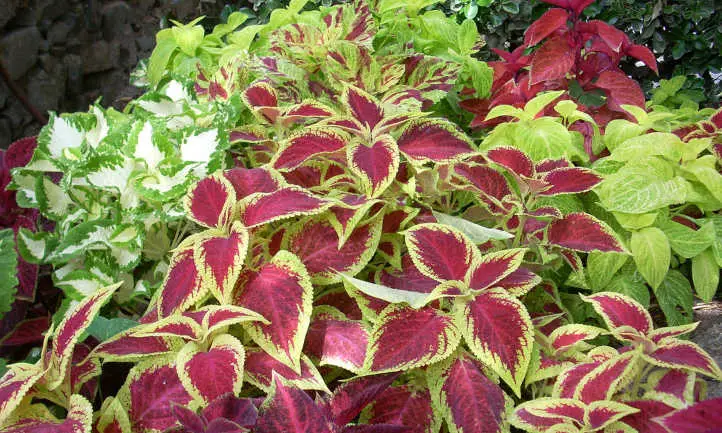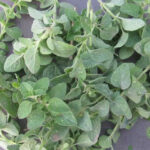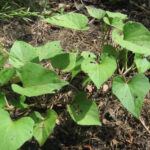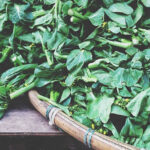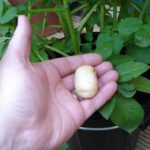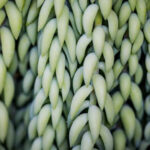Coleus is a gorgeous ornamental plant with many different forms depending on the variety. Its colorful foliage is what makes people want to nurture an indoor coleus plant or grow them outdoors. If you’re aesthetically specific when it comes to gardening, chances are there are coleus varieties that suit your preferred look.
But what is this plant? Sometimes called painted nettle, they are multi-hued, stunning plants grown for their leaves rather than flowers. They are excellent for container gardening even in summer or for adoring garden beds, they offer amazing color in partial shaded areas.
Today, we’re going to narrow in on ornamental coleus plants. We’ll touch on coleus varieties, and discuss general care for those mentioned. Then you can plant coleus and care for it at home.
Subscribe to the Epic Gardening Podcast on iTunes or Spotify
Quick Care Guide
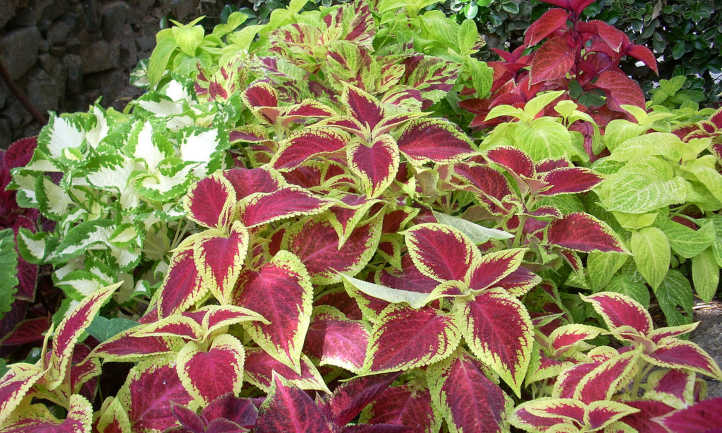
| Common Name | Coleus, painted nettle, plus over a thousand cultivar names |
| Scientific Name | Coleus scutellarioides, or Coleus blumei |
| Family | Lamiaceae |
| Height & Spread | 10-30 inches tall, 1-3 feet wide depending on variety |
| Light | Part shade ideal, full shade also okay. Some summer sun tolerant cultivars. |
| Soil | Well-draining soil |
| Water | 2 inches per week |
| Pests & Diseases | Mealybugs, aphids, spider mites, whiteflies, slugs, fungal root and stem rot, downy mildew |
All About Coleus Plants
Coleus (known botanically as Coleus scutellarioides, or C. blumei) is also referred to as painted nettle. There are many other common names that refer to particular coleus varieties. These flowering plants are native to Australia and Southeast Asia. These short-lived perennial plants are variable in size, shape, and color. In their native habitat, they are found in low-lying and medium-high altitudes that are heavily shaded.
As a member of the mint family, their leaves grow on opposite square stems and have a flower spike that blooms at maturity, assisting in reproduction by coleus seeds. Each of the flowers contains seeds that reproduce and vary in color based on the variety in question. Flower spikes emerge at almost any time of year in their native range. Their roots are long, branching taproots. Coleus plants are easily propagated by stem cuttings, much like basil plants are.
While some wild varieties of coleus have foliage colors that are variegated, the exaggerated variegation in some is purely due to extensive cultivation. But don’t fall for blue coleus, as these are fake. Each variety also has dense foliage and different leaf texture dependent on traits that have been selected and viable in cultivation. There are trailing coleus and there are bushy types. There are ways to encourage bushier growth too.
Today, people grow coleus in hanging baskets, containers, and shady garden beds where these lush plants provide a pop of color and texture.
Types Of Coleus
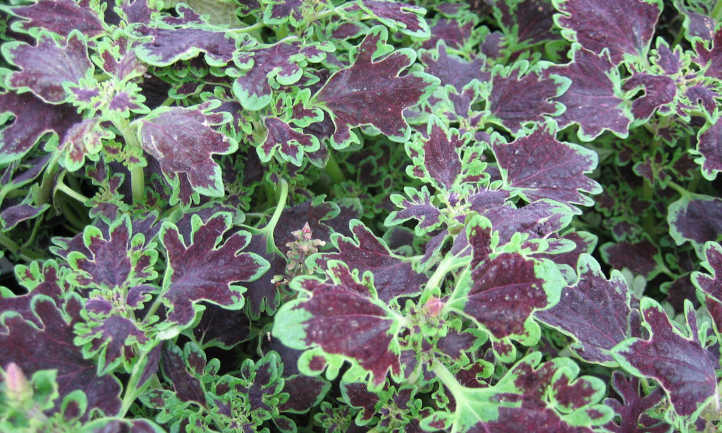
Here are a few of the coleus types available in the nursery world. We’ve selected those with the most colorful foliage and interesting growth habits to showcase here.
- Wizard: part of the premium sun series great for summer, and great for those who can’t decide! This plant is a variety of colors and textures packed into one. All are variegated with bushier growth, and a range of orange to pink to lime green to yellow leaves, bright red leaves, and burgundy leaves. Plenty of new introductions are available.
- Volcano: these have lacey leaf margins, pale yellow to green, and deep red centers.
- Kong Coleus: the Kong series has starkly bicolored with a thick pale yellow-green border, and a deep maroon leaf center. These come in mixes or with varying ruby-hued centers.
- Florida Sun Rose: pale to rosy pink edges with a deep purple center that is almost black. Often, there will be green, yellow, or red highlight colors as well.
- Inky Fingers, Inky Toes: both feature a green outer edge with burgundy leaves and deep burgundy stems. Inky Fingers resembles a hand. By comparison, Inky Toes has a blot-like pattern with a few extensions of color. Great when interplanted with tall flowers.
- Fishnet Stockings: enormous leaves with purple coleus leaf veins. Fishnet stockings has bright lime gold leaves and needs full shade.
- Black Dragon: richly-shaded magenta to black leaves that are great among lightly colored flowers.
- Wasabi: lime green leaves, with elegantly-shaped serrated leaves that are fiercely pointed. This is one of the varieties that has solid colors.
- Mardi Gras: bright yellow-green leaves that have maroon to fuschia paint splatters.
- Henna: feathered and slightly curled leaf shape, mixed with its yellow and brick-red leaves, mimics autumn’s tones perfectly
- Burgundy Wedding Train: red coleus with green leaf borders that makes a lovely coleus indoor plant.
Coleus Care
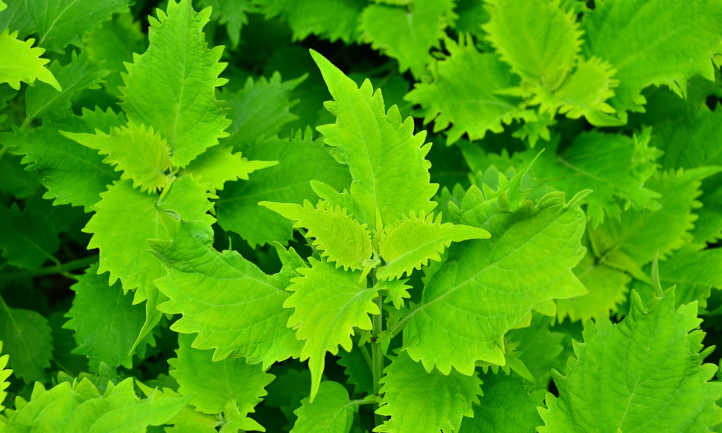
Now that we’ve discussed some of the varieties of coleus you can incorporate into your flower garden, let’s talk about how to care for this plant. Here are some gardening tips for these easy-going outdoor or indoor plants.
Planting Coleus
If you’re growing coleus from seed, germinate seeds in containers 10 weeks before the last frost date. It’s easiest to start coleus seed indoors. If you’re growing container plants outdoors, our you plant coleus in the ground, place them outside after the danger of frost has passed in spring. If you’re planting in the ground, ensure the spot you choose is well-draining, out of direct winds, and gets partial shade, especially in the full sun of the afternoon. Begin in late spring, planting the entire root ball in a hole in the ground that is just slightly wider and almost as deep as your starter plant. Spread the original soil around the base of the planting, and water it well. Water daily for a week after planting as it is getting established.
Sun and Temperature
When it comes to coleus, sun or shade is the question. When you grow a coleus plant indoors this is no problem at all. Outdoors, coleus thrives in areas with part sunlight, where the hot sun is blocked by trees above. Too much sunlight bleaches those gorgeous leaves, so provide at least some shade. Direct early morning sun and light shade in the afternoon is best. Some varieties like the Wizard series can tolerate sun easily. There is coleus for sun. The ideal temperature for these plants is between 70 and 100 degrees. The heat of late summer isn’t an issue, but cold can be. If the temperature dips below 50 degrees, cover them with a cold frame, or bring them indoors and provide indirect light for them. Ensure they are protected before the first frost arrives. In warmer zones, you may not have to deal with this at all. Coleus plants are hardy in USDA zones 10 and 11, where they are perennials. In zones with cold winters, these are tender annuals.
Water and Humidity
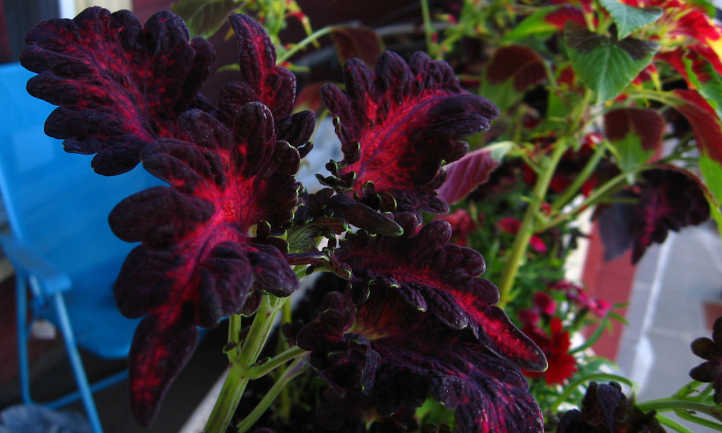
When you first plant your plant, water it until the soil is saturated. Afterward, don’t get the soil overly wet, because that causes leaf drop, and creates conditions where root rot can thrive. Water only when the top inch of soil becomes dry, and keep it at an even moisture. You do not want muddy soil, just lightly moist! Water in the morning with soaker hoses or drip irrigation. Most coleus in containers will do just fine with light irrigation from a watering can. You won’t need to water as much in winter while the plant is dormant. One of the trickier aspects of coleus care is ensuring humidity is high enough for your plants. Instead of misting them, use a humidifier indoors, and plant coleus near water sources, or low-lying shady areas outdoors.
Soil
Coleus grow best in well-draining soil. Don’t use soils that contain a lot of vermiculite or polymer moisture absorbers. A blend that has lots of perlite is preferable, as it aerates the soil and improves drainage. Mulch your soil’s surface with a gravel mulch. This keeps moisture in the soil and reduces watering frequency. Having mulch beneath the plants will also help prevent disease spread. Poor quality soil will not help your plants grow. They do best in soil rich in nutrients. The optimal pH for coleus is 6 to 7.
Fertilizing
If your plants are in containers, give them liquid fertilizer or a balanced, water-soluble fertilizer during the growing season once per month – especially in mid-summer. If they are in a garden bed, slow-release granular fertilizer is fine too. 10-10-10 liquid fertilizer or granule fertilizer is great for these plants. If that’s not available, opt for one which is higher in nitrogen than everything else, as that will spur leaf and plant growth. Cut back on fertilizer in winter, as this is the dormant season.
Pruning Coleus Plants

When you see a coleus flower the plant is going into seed production. Pinch growing shoots before they can bloom. As these are typically annuals, they can die off after flowers appear. Pinching the blooms off redirects the plant’s energy to leaf and plant growth. Like most mint relatives, these can get spindly. To encourage a bushy plant, cut or pinch off leggy stems just above a leaf node. Choose a node that has a visible bud forming. Do this to encourage branching at that location, and train the growth habit of your coleus overall.
Repotting Coleus Plants
When repotting coleus grown indoors, do not plant the coleus any lower in the pot than it was originally planted. Prepare your larger pot with good quality potting soil, then remove the coleus from its other pot. Gently separate the root mass with your hands, then place it in the new pot. Be careful not to break its large taproot! Scoop soil around the plant’s base to fill in any gaps, and lightly press down to secure it in place. Do not tightly pack the soil, as nature will pack it down for you.
Coleus Propagation
For growing coleus by seed, it is easiest to start seed indoors. Use a seedling tray filled with potting soil and broadcast seed evenly across the surface. Once the seed is spread, put a thin layer of medium overtop. Place a dome over the seedling tray and place it in bright, indirect lighting in a warm spot. You should begin to see young plants within two weeks. When they appear, remove the plastic cover. Water young plants frequently. It’s safer for your seedlings if they are watered from the bottom of the tray rather than overhead. When they are a few inches tall, plant them in their container or in the garden. For growing coleus by taking cuttings, take cuttings with a sharp and clean pair of scissors. Remove cuttings that are 4 to 6 inches tall from your plants. Make a cut right beneath a leaf node along the stem. Dip the cuttings into rooting hormone. Using a pencil, make a hole in your prepared potting mix in your containers and place the cutting into the hole. Gently press around the stem. Place your planted cutting into a plastic bag, being careful to keep the plastic from touching the cutting. Keep the soil moist, but not wet, and place it in a warm location with indirect bright lighting. Your plant should take root within a couple of weeks. You will know rooting has occurred if new growth begins to form. At that point, remove the plastic bag. Then you can wait for the right temperature and place your coleus in your garden in light shade.
Troubleshooting

Now that we’ve discussed coleus plants care, let’s talk about potential problems. There aren’t a ton of issues facing coleus outdoors or indoor coleus. But there are a few things to look out for.
Growing Problems
Many varieties grown in full sun conditions can experience sun scalded leaves. Occasionally translucent patches on the leaf’s surface can turn into holes. These symptoms are more prevalent or occur more often if the plant is underwatered or overwatered. To avoid leaf scalding, ensure that your plants have at least partial shade conditions. Afternoon shade is better than morning shade, as there is more sun in the afternoon. If you must plant coleus in a full sun location, pick a variety that is light-tolerant. There are many varieties bred for sun tolerance now, so there’s a wide selection to choose from. If your coleus gets too much water, the leaves may yellow. Ensure you let the top inch of soil dry out between watering your coleus cultivars.
Pests
Mealybugs can leave a whitish residue along stem joints and will suck the plant’s sap out. Aphids are also sap-suckers, and can quickly cause a plant to wither if they’re present in large quantities. Whiteflies, too, will drink your plant’s sap, and you can easily see when they’re becoming a problem in the garden or greenhouse. And then there are spider mites, which will feast on both the plant’s leaves and the sap, leaving a fine web-like material behind. All four of these pests can be dealt with using insecticidal soap. To prevent these insects from ever infesting your plants, use regular applications of neem oil as a deterrent. Also, beneficial insects such as ladybugs or lacewings will happily feast on all four of those pests, keeping them at bay. Plant plants that beneficial insects love around your perennial coleus.
There is one other pest that will nibble your plants into oblivion: the common garden slug. They creep in at night and feed and may take up residence beneath your plants during the daytime. A beer trap distracts slugs and snails giving them a tavern to drown themselves in rather than eating your plants. Organic slug and snail bait is a good secondary measure.
Diseases
Overwatering your plants can cause fungal issues such as stem rot and root rot. Avoid overwatering to avoid the rot, and use gravel mulch beneath your plants as it dries out quicker.
If stem or root rot becomes apparent on your plants, prune off all signs of the rot, and transplant them into new sterile potting soil. For cultivars you’re growing in-ground, carefully remove your plant from its pot or bed. Swish the roots in a bucket of clean water to dislodge any fungally-infected soil. Trim any roots that are brown or mushy. If the central taproot has become rotten, destroy the plant. Repot your plant in sterile potting soil. Do not replant in infected soil.
Downy mildew may be a problem that’s far more prevalent in greenhouses. Treat this with neem oil. Spray the oil thoroughly coating both the tops and bottoms of the leaves. Reapply every few days until the problem subsides. Prune off damaged leaves after treatment is done.
Frequently Asked Questions
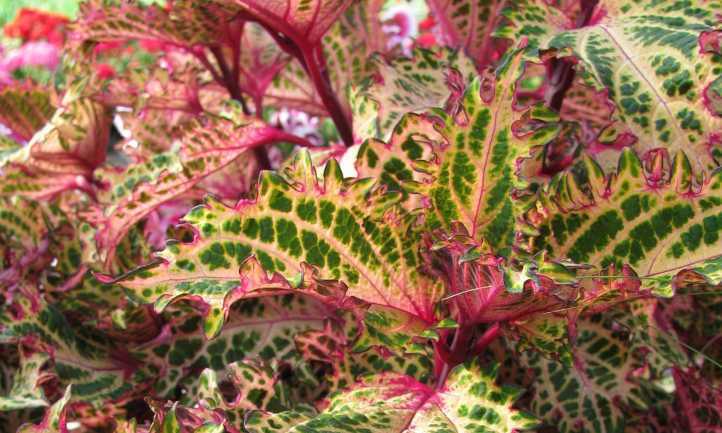
Q: Does coleus like sun or shade?
A: Care of coleus involves partial shade.
Q: Do coleus come back every year?
A: In areas where the plant is perennial, yes! Otherwise, they’ll survive all year indoors.
Q: Is coleus a perennial or annual?
A: It depends on how you grow it. See above.
Q: How long do coleus plants live for?
A: Those with proper coleus plant care and kept out of frost will live for 3 to 4 years.
Q: Is coleus a good houseplant?
A: Yes! Its large leaves and upright stems are bright and lovely wherever they live.
Q: Can coleus be planted in the ground?
A: Yes, but they’ll need protection from frost.
Q: Can I leave coleus outside in winter?
A: If you live in zones 10 and 11 they’ll survive winter.
Q: Should you let coleus flower?
A: You can, but the appearance of coleus flowers means the plant is maturing. Pinch off the spike of a coleus flowering to extend its life.
Q: Is coleus toxic to dogs?
A: It is highly toxic to dogs. Keep the plants away from them as their skin can be irritated. Ingesting can kill them.
Q: Is coleus monocot or dicot?
A: It is an herbaceous dicot. It has a longer, thicker taproot surrounded by smaller roots, and forms net-like veining in its leaves. It also has multiple flowers instead of single flowers on a stem.

